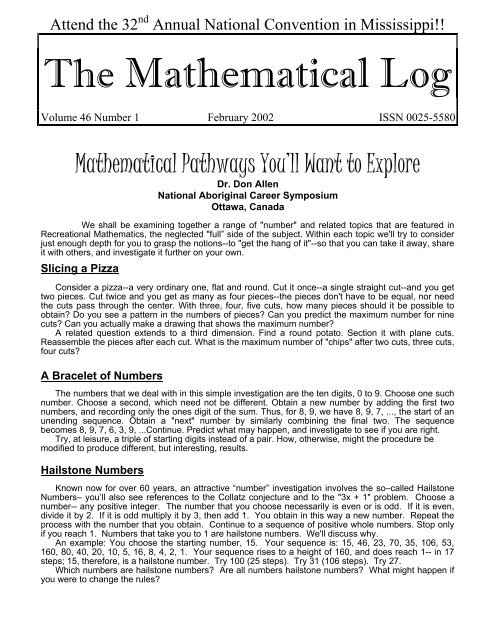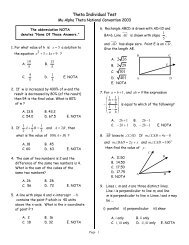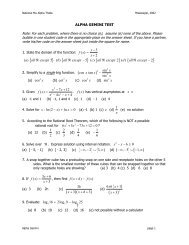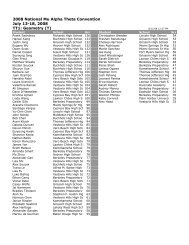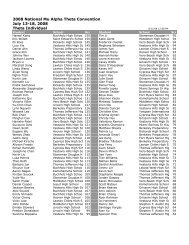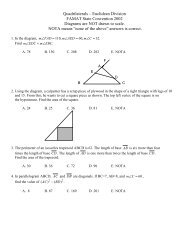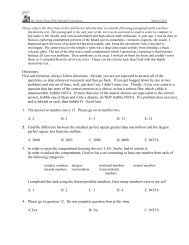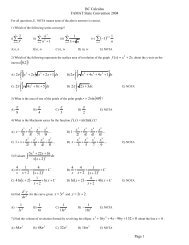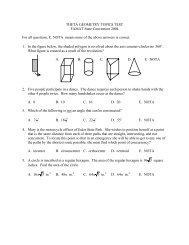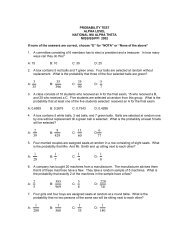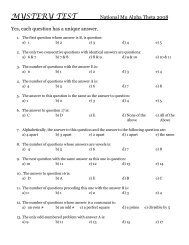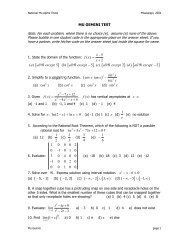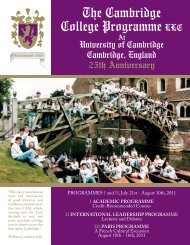February 2002 - Mu Alpha Theta
February 2002 - Mu Alpha Theta
February 2002 - Mu Alpha Theta
You also want an ePaper? Increase the reach of your titles
YUMPU automatically turns print PDFs into web optimized ePapers that Google loves.
Attend the 32 nd Annual National Convention in Mississippi!!<br />
The Mathematical Log<br />
Volume 46 Number 1 <strong>February</strong> <strong>2002</strong> ISSN 0025-5580<br />
Mathematical Pathways You’ll Want to Explore<br />
Dr. Don Allen<br />
National Aboriginal Career Symposium<br />
Ottawa, Canada<br />
We shall be examining together a range of "number" and related topics that are featured in<br />
Recreational Mathematics, the neglected "full” side of the subject. Within each topic we'll try to consider<br />
just enough depth for you to grasp the notions--to "get the hang of it"--so that you can take it away, share<br />
it with others, and investigate it further on your own.<br />
Slicing a Pizza<br />
Consider a pizza--a very ordinary one, flat and round. Cut it once--a single straight cut--and you get<br />
two pieces. Cut twice and you get as many as four pieces--the pieces don't have to be equal, nor need<br />
the cuts pass through the center. With three, four, five cuts, how many pieces should it be possible to<br />
obtain Do you see a pattern in the numbers of pieces Can you predict the maximum number for nine<br />
cuts Can you actually make a drawing that shows the maximum number<br />
A related question extends to a third dimension. Find a round potato. Section it with plane cuts.<br />
Reassemble the pieces after each cut. What is the maximum number of "chips" after two cuts, three cuts,<br />
four cuts<br />
A Bracelet of Numbers<br />
The numbers that we deal with in this simple investigation are the ten digits, 0 to 9. Choose one such<br />
number. Choose a second, which need not be different. Obtain a new number by adding the first two<br />
numbers, and recording only the ones digit of the sum. Thus, for 8, 9, we have 8, 9, 7, ..., the start of an<br />
unending sequence. Obtain a "next" number by similarly combining the final two. The sequence<br />
becomes 8, 9, 7, 6, 3, 9, ...Continue. Predict what may happen, and investigate to see if you are right.<br />
Try, at leisure, a triple of starting digits instead of a pair. How, otherwise, might the procedure be<br />
modified to produce different, but interesting, results.<br />
Hailstone Numbers<br />
Known now for over 60 years, an attractive “number” investigation involves the so–called Hailstone<br />
Numbers– you’ll also see references to the Collatz conjecture and to the "3x + 1" problem. Choose a<br />
number-- any positive integer. The number that you choose necessarily is even or is odd. If it is even,<br />
divide it by 2. If it is odd multiply it by 3, then add 1. You obtain in this way a new number. Repeat the<br />
process with the number that you obtain. Continue to a sequence of positive whole numbers. Stop only<br />
if you reach 1. Numbers that take you to 1 are hailstone numbers. We'll discuss why.<br />
An example: You choose the starting number, 15. Your sequence is: 15, 46, 23, 70, 35, 106, 53,<br />
160, 80, 40, 20, 10, 5, 16, 8, 4, 2, 1. Your sequence rises to a height of 160, and does reach 1-- in 17<br />
steps; 15, therefore, is a hailstone number. Try 100 (25 steps). Try 31 (106 steps). Try 27.<br />
Which numbers are hailstone numbers Are all numbers hailstone numbers What might happen if<br />
you were to change the rules
<strong>February</strong> <strong>2002</strong> The Mathematical Log Page 2<br />
Mathematical Pathways You’ll Want to Explore continued…<br />
A Square of Differences<br />
This simple number investigation can yield quite surprising results. Something seems to be<br />
controlling what is happening, but it can be hard to see exactly what.<br />
To begin, draw a large square. Then choose four numbers-- zero or positive whole numbers.<br />
Assign each number, in order, to a corner of your square. Choose, for example, 3, 11, 2, 6. Now, add dot<br />
at the midpoint of each side of your square. Join dots so as to make an inner "diamond"--actually, a tilted<br />
square. At each corner of this square, write the number that is the difference (big minus little) of the two<br />
numbers ending that side of the bigger square. Obtain, in the example we started with, 8, 9, 4, 3. Repeat<br />
the process, getting 1, 5, 1, 5. Again: 4, 4, 4, 4. And again: 0, 0, 0, 0. How did this happen Will all<br />
starting numbers take you to 0, 0, 0, 0 In so few steps Students once showed me numbers that<br />
reached 0, 0, 0, 0 only after 15 steps. Can you equal that Also, what might have happened if we'd<br />
chosen a triangle or a hexagon instead of a square<br />
Reversals to a Palindrome<br />
A "palindrome"-- a very old term-- is a number, word, or expression that reads the same left-toright<br />
as right-to-left. As for examples, 383, 4664, and 1052501 are number palindromes. Similarly, eye,<br />
level, and radar are word palindromes. Also, “Was it a cat I saw”, “Able was I ere I saw Elba” (attributed<br />
to Napoleon), and “A man, a plan, a canal— Panama” are sentence palindromes.<br />
We shall focus on number palindromes.<br />
To begin, choose a number of two or more digits, probably not a palindrome. (If the number<br />
happens to be a palindrome, then the activity is over.)<br />
The “reversal” of such a number is the number obtained when the digits are written in reverse<br />
order. Thus, the reversal of 326 is 623, and of 990 (let’s agree) is 099.<br />
Write the number that you have chosen. Write its reversal. Add these two numbers. It’s quite<br />
possible that, in one step (one reversal, one addition) you obtain a palindrome.<br />
Thus, 623+326 = 949, a palindrome, in one step.<br />
If not, repeat the whole process. Repeat using the sum that you obtained— writing the sum, its<br />
reversal, and adding these two numbers. It’s quite possible that, in these two steps, you obtain a<br />
palindrome. Thus, for the number 58: 58+ 85 = 143, then 143+ 341 = 484, a palindrome in two steps.<br />
Further, 157 gives a palindrome in three steps:<br />
157 + 751 = 908, 908 + 809 = 1717, 1717+7171 = 8888.<br />
Explore.<br />
Check whether 990 reaches a palindrome in five steps. Check whether 79 gives a palindrome in<br />
six steps. Check whether 395 gives a palindrome in seven steps.<br />
My students inform me that 89 gives a palindrome, but that some big numbers are reached and<br />
surprisingly many steps are required.<br />
Is every number either a palindrome or else a limited number of such steps from being one<br />
Kaprekar’s Constant<br />
This number activity has more general possibilities, but to introduce it we focus on its four-digit<br />
case. First, write down a four-figure number (not all digits the same), say 3529. Now, rearrange the<br />
digits to form the largest number that you can (9532, I suggest) and the smallest such number (2359).<br />
Subtract these two numbers (large minus small), and get a new number, 7173. Repeat the process:<br />
7731- 1377 = 6354. Repeat again: 6543 - 3456 = 3087. And again: 8730- 0378 = 8352. And again: 8532<br />
- 2358 = 6174. Now, observe: 7641 -1467 = 6174… again, and again! For the amateur mathematician<br />
who discovered it, D. R. Kaprekar (he lived in India), this number, 6174, is now known as Kaprekar's<br />
constant. Four-figure numbers "lead to" 6174. Why Show that 9017 leads to 6174 in three steps, 9017<br />
leads to 6174 in seven steps. Would there be a Kaprekar constant for three- figure numbers ...for fivefigure<br />
numbers<br />
What next A Math Fair project or math-related Science Fair investigation<br />
could arise from such explorations. Some good reading I recommend<br />
Martin Gardner’s many recreations books.<br />
--- Dr. Don Allen
<strong>February</strong> <strong>2002</strong> The Mathematical Log Page 3<br />
Win a trip to the <strong>2002</strong><br />
National Convention!<br />
What's at stake Convention registration for a sponsor and a non-senior student and travel expenses<br />
up to $500 (travel arranged by the national office) for each of you to the national <strong>Mu</strong> <strong>Alpha</strong> <strong>Theta</strong><br />
Convention in Starkville, Mississippi. July 26-31, <strong>2002</strong>. A total of twelve of these prizes will be<br />
awarded— three per region.<br />
Who is eligible Any newly chartered chapter or chapter that has not been represented at the national<br />
within the past three years.<br />
How to enter Write two paragraphs about your chapter, one describing the events your chapter has<br />
participated in this academic year, and the other describing how your chapter will benefit from<br />
representation at the convention. While you're at the convention, you will be asked to complete<br />
surveys (one for the sponsor and one for the student) describing your feelings about the convention<br />
and how your chapter will benefit from your participation at the convention.<br />
Mail entries to:<br />
<strong>Mu</strong> <strong>Alpha</strong> <strong>Theta</strong> National Office<br />
601 Elm Ave, Rm 423<br />
Norman, OK 73019<br />
ENTRIES MUST BE POSTMARKED BY<br />
MAY 15, <strong>2002</strong><br />
News<br />
• MAΘ National Convention • MAΘ National Listserv<br />
Come for a heapin’ helpin’ of Southern hostipality, charm,<br />
and…<br />
`tzÇÉÄ|t `tà{<br />
32 nd Annual <strong>Mu</strong> <strong>Alpha</strong> <strong>Theta</strong> National Convention<br />
Mississippi State University<br />
Starkville, Mississippi<br />
July 26- 31,<strong>2002</strong><br />
Hosted by Mississippi School of Mathematics and Science<br />
The Convention Registration Packet is now<br />
available on-line at www.mualphatheta.org<br />
For more information contact:<br />
Claudia Carter (ccarter@msms.k12.ms.us)<br />
or<br />
Aubrey Knight (aknight@msms.k12.ms.us)<br />
• MAΘ Website<br />
Check out the National Office website at<br />
http://www.mualphatheta.org/<br />
for the latest information from the National Office.<br />
In an organization as large and as geographically vast as <strong>Mu</strong><br />
<strong>Alpha</strong> <strong>Theta</strong>, a listserv can provide a convenient way for members<br />
to keep in touch and up-to-date on events and topics. Since every<br />
member sees each posted email, it provides an excellent way to<br />
distribute information quickly. The list also provides a forum for<br />
extended discussions. Members can read each post when<br />
convenient and, if desired, submit their comments or suggestions.<br />
There are two ways to subscribe:<br />
1. Send an email to<br />
<strong>Mu</strong><strong>Alpha</strong><strong>Theta</strong>-subscribe@topica.com.<br />
The listserv will automatically extract your email address and<br />
add you to the list.<br />
2. A subscription form is also available at:<br />
http://www.topica.com/lists/<strong>Mu</strong><strong>Alpha</strong><strong>Theta</strong>/subscribe/location=listinfo<br />
If you still can't subscribe, send an email to Sam Koski at<br />
ASKoski@aol.com with the email addresses that you want added.<br />
• MAΘ Student Delegate/Chapter<br />
President Listserve<br />
Student Delegates and Chapter Presidents are invited to<br />
join a listserv by sending a blank e-mail to mailto:subscribedelegate@topica.com.<br />
Student delegates and chapter<br />
presidents can all play a large role in the success of <strong>Mu</strong><br />
<strong>Alpha</strong> <strong>Theta</strong> this year, through this mailing list. Throughout<br />
the year the listserv will provide a chance to have an open<br />
discussion of any topics related to <strong>Mu</strong> <strong>Alpha</strong> <strong>Theta</strong>.<br />
Sponsors are also invited to join the list to provide<br />
additional suggestions and comments for members.
<strong>February</strong> <strong>2002</strong> The Mathematical Log Page 4<br />
<strong>Mu</strong> <strong>Alpha</strong> <strong>Theta</strong> Awards<br />
The Lucent Technologies Foundation is sponsoring an<br />
annual international competition to identify and reward the<br />
academic excellence and scientific achievement of 60<br />
students. The Institute of International Education manages<br />
the competition in the 18 participating countries/regions:<br />
Australia, Brazil, Canada, China/Hong Kong, France,<br />
Germany, India, Korea, Japan, the Netherlands, Saudi<br />
Arabia, Singapore, Spain, Taiwan, the United Kingdom,<br />
and the United States.<br />
Chosen applicants receive $5,000 cash along<br />
with an invitation to participate with Bell Labs researchers<br />
and fellow Global Science Scholars from around the world<br />
in the Global Summit during the summer of <strong>2002</strong>. In<br />
addition, the recipient will be considered for an internship<br />
at Lucent Technologies in the home country.<br />
Visit the Institute for International Education<br />
website at http://www.iie.org/pgms/lucent/ for details,<br />
including specific eligibility and application requirements,<br />
a downloadable application form, and contact information<br />
for the program coordinator nearest you.<br />
Don’t forget!<br />
The acclaimed Art of Problem Solving<br />
series is still available from the<br />
National Office. Check the website for<br />
more information.<br />
Misunderstanding<br />
Each <strong>Mu</strong> <strong>Alpha</strong> <strong>Theta</strong> chapter would not be possible without the endless<br />
hours of devotion given by its sponsor. To honor these dedicated<br />
sponsors, the <strong>Mu</strong> <strong>Alpha</strong> <strong>Theta</strong> Governing Council presents the Huneke<br />
Distinguished Sponsor Award and the Student Delegate Assembly gives<br />
the Sister Scholastica Award. Sponsors who are recipients of these<br />
awards must be present at the national convention.<br />
Both of these honors recognize individuals who have instilled in <strong>Mu</strong><br />
<strong>Alpha</strong> <strong>Theta</strong> members a desire to explore the topics in mathematics that<br />
are usually not covered in a high school mathematics curriculum.<br />
In addition to honoring sponsors, the <strong>Mu</strong> <strong>Alpha</strong> <strong>Theta</strong> Governing Council<br />
recognizes two members who are graduating high school seniors. The<br />
Kalin Award, awarded at the National Convention, recognizes an<br />
exceptional <strong>Mu</strong> <strong>Alpha</strong> <strong>Theta</strong> member. The Andree Mathematics<br />
Education Award recognizes an outstanding student who is planning to<br />
be a mathematics teacher. The Andree Awardee does not have to be<br />
present at the National Convention.<br />
If you would like more information on any of these award, visit<br />
www.mualphatheta.org/awardships/awards.html. Please consider<br />
nominating a student or a sponsor for one of these awards.<br />
The Mathematical Log<br />
Volume 46, Number 1, <strong>February</strong> <strong>2002</strong><br />
The Mathematical Log is the official publication of <strong>Mu</strong> <strong>Alpha</strong> <strong>Theta</strong>, a<br />
national high school and junior college mathematics honor society and<br />
mathematics club federation. Founded in 1957 by Richard and Josephine<br />
Andree, <strong>Mu</strong> <strong>Alpha</strong> <strong>Theta</strong> is co-sponsored by the Mathematical<br />
Association of America (MAA), the National Council of Teachers of<br />
Mathematics (NCTM), and the Society of Industrial and Applied<br />
Mathematics (SIAM). Correspondence may be directed to <strong>Mu</strong> <strong>Alpha</strong><br />
<strong>Theta</strong> National Office, 610 Elm Ave., Room 423, Norman, OK 73019,<br />
email: nationaloffice@mualphatheta.org, or to Log editor Pat Bowler<br />
Johnson, New Trier High School, 385 Winnetka Avenue, Winnetka, IL<br />
60093, email: bowlerjp@newtrier.k12.il.us.<br />
© <strong>2002</strong> <strong>Mu</strong> <strong>Alpha</strong> <strong>Theta</strong><br />
National Officers:<br />
President:<br />
Harold Reiter<br />
University of North Carolina, Charlotte, NC<br />
Past-President:<br />
Claudia Carter<br />
Mississippi School for Math and Science<br />
Secretary-Treasurer:<br />
Paul Goodey<br />
University of Oklahoma, Norman, OK<br />
Governor Region I:<br />
Tom Norris<br />
Thomas Jefferson High School, Auburn, WA<br />
Governor Region II:<br />
Mattie White<br />
Benjamin Franklin High School, New Orleans, LA<br />
Governor Region III:<br />
Susan Hiller<br />
Vero Beach High School, Vero Beach, FL<br />
Ah, you are a mathematician,<br />
they say with admiration<br />
or scorn. Governor Region IV: Gary Walker<br />
Then, they say,<br />
I could use you<br />
Carter High School, Strawberry Plains, TN<br />
MAA Representative: J. Douglas Faires<br />
Youngstown State University, Youngstown, OH<br />
NCTM Representative: Dorothy Martin<br />
Bellevue High School, Bellevue, WA<br />
to balance my checkbook. SIAM Representative: Terry Herdman<br />
Virginia Tech Interdisplinary Center for Applied<br />
Mathemathics, Blacksburg, VA<br />
I think about checkbooks. Publications: Pat Bowler Johnson<br />
New Trier High School, Winnetka, IL<br />
Once in a while<br />
Executive Assistant: Diane Rubin<br />
I balance mine,<br />
just like sometimes<br />
I dust high shelves.<br />
President: Alex Lee<br />
--Joanne Growney<br />
Joanne Growney is a former mathematics professor at<br />
Bloomsburg University and is author of My Dance is<br />
Mathematics, a collection of poems influenced by her<br />
studies and experiences teaching math.<br />
University of Oklahoma, Norman, OK<br />
National Student Officers:<br />
Vice-President:<br />
Secretary-Treasurer:<br />
Sergeant-at-Arms:<br />
North Broward Preperatory, FL<br />
StormLX@aol.com<br />
Elaine Hart<br />
Mount Rainer High School, WA<br />
Megan Repar<br />
Lafayette High School, LA<br />
Nathaniel Watson<br />
Farragut High School, TN
<strong>February</strong> <strong>2002</strong> The Mathematical Log Page 5<br />
2001 Sister Scholastica Award Winner<br />
Peggy Patout<br />
Catholic High School<br />
Baton Rouge, Louisiana<br />
Mrs. Peggy Patout recently won the Sr.<br />
Scholastica Award at the 2001 National Convention. As<br />
the nominating student, I have the honor of writing an<br />
article centered about this incredible person. It is my<br />
intent to impart upon you in some small way the depth and<br />
breadth of the impact that Mrs. Patout has had upon my<br />
life and the lives of students in my high school. As a<br />
member of <strong>Mu</strong> <strong>Alpha</strong> <strong>Theta</strong> for five years, I have spent<br />
much of my high school career in the presence of Mrs.<br />
Patout and have strong testimony as to her efforts in the<br />
development of her students into complete men. It is my<br />
intent to relate a few stories that will best convey Mrs.<br />
Patout’s deep commitment to the mission of <strong>Mu</strong> <strong>Alpha</strong><br />
<strong>Theta</strong> and to the people within it.<br />
In my eighth grade year at Catholic High School,<br />
the <strong>Mu</strong> <strong>Alpha</strong> <strong>Theta</strong> organization under Mrs. Patout’s<br />
guidance decided to host a math tournament for local<br />
middle and junior-high school students. The motivation<br />
for this tournament came purely from the desire to spread<br />
interest in mathematics to students who have not yet<br />
reached high school. Mrs. Patout has spent her years as<br />
sponsor of <strong>Mu</strong> <strong>Alpha</strong> <strong>Theta</strong> attempting to imbue the<br />
members of the CHS chapter with a sharp interest in<br />
mathematics and in the teaching of mathematics. She<br />
joined that message with one of service to the community<br />
through tournaments like this. It is evident by the spirit of<br />
her members that she has been tremendously successful in<br />
this endeavor.<br />
Mrs. Patout has the belief that all students can<br />
become interested in math if it is taught in the correct<br />
manner. Mrs. Patout felt so strongly about this that she<br />
requested to not teach just honors students. Every year<br />
Mrs. Patout teaches academic level students, honors<br />
students, and AP level students. She achieves tremendous<br />
success in each level. AP Scores and spring testing hours<br />
for her AP and honors classes are her marks of success.<br />
The most amazing indication of achievement has a much<br />
greater impact on the world than the level of mastery she<br />
teaches her students. In the past five years that I have<br />
been associated with her, she has inspired numerous<br />
students towards the pursuit of teaching degrees in<br />
mathematics. Many more students she has simply taught<br />
to admire teachers. Each student has no problem telling<br />
you that Mrs. Patout is the reason for his career choice.<br />
This is perhaps the greatest illustration of the dedication,<br />
strength, and skill that Mrs. Patout possesses.<br />
On a personal note, I have worked for several<br />
years with her as an officer in <strong>Mu</strong> <strong>Alpha</strong> <strong>Theta</strong>. Because<br />
of our work together, I can speak from experience when I<br />
say that I have<br />
seen no sponsor<br />
anywhere who is<br />
more dedicated,<br />
kind, caring, and<br />
influential than<br />
Mrs. Patout. I owe<br />
her a great debt<br />
for the past five<br />
years of my life.<br />
Her desire is for<br />
me to become a<br />
productive and<br />
caring member of<br />
society. That is all<br />
that she wants in<br />
the way of repayment for her work. That, perhaps, says<br />
the most about her character.<br />
Perhaps the greatest thing that I take with me to<br />
college from my years with Mrs. Patout is a simple<br />
concept that has changed my whole way of thinking. She<br />
has told me time and time again that awards should never<br />
be the aim of your work. She believes that the true reward<br />
of the things that she does lies in the knowledge that she<br />
has changed the life of another person. With all of this<br />
said, it is easy to see why Mrs. Patout is someone who<br />
deserves with every ounce of meaning the Sister<br />
Scholastica award, whether she would like to admit it or<br />
not.<br />
David Smith<br />
Catholic High School<br />
Baton Rouge, LA<br />
Do you know a <strong>Mu</strong> <strong>Alpha</strong> <strong>Theta</strong> sponsor like Mrs. Patout Go to the <strong>Mu</strong> <strong>Alpha</strong><br />
<strong>Theta</strong> website and check under “Awards and Scholarships” to find out more<br />
about how the history of the Sister Scholastica Award and how you can<br />
nominate your sponsor for this award!<br />
http://www.mualphatheta.org/awardships/awards.html
<strong>February</strong> <strong>2002</strong> The Mathematical Log Page 6<br />
Math Students Race to Turn In…<br />
Toilet Paper<br />
by Seema Kakad<br />
Myers Park High School<br />
Charlotte, North Carolina<br />
The Math Honor Society at Myers Park High<br />
School has a new face. Suddenly, students aren't just<br />
running to Mr. Aizenman's room to turn in late candy<br />
money or to get their ticket for the next pizza party--<br />
they're running to turn in… toilet paper That's right.<br />
<strong>Mu</strong> <strong>Alpha</strong> <strong>Theta</strong>, traditionally a social club for<br />
students who enjoy math, has turned into a social and<br />
service club under the leadership of Advisor Ben<br />
Aizenman, President Charlie Odom, Vice-President<br />
Seema Kakad, Secretary Mary Werden, and<br />
Treasurer Mousumi Medda.<br />
For the November service project, over one<br />
hundred math students in the 11th and 12th grade<br />
brought in over 500 toiletry items for the Men's<br />
Shelter in downtown Charlotte. Items ranged from<br />
toothbrushes and deodorants to, yes, even toilet<br />
paper. The officers delivered all six box loads to the<br />
Men's Shelter on Tuesday, December 4th, to discover<br />
that the shelter had just run out of toiletry items-- this<br />
new delivery was perfect timing.<br />
So what's next for the Math Honor Society<br />
Students are already racing to Mr. Aizenman's room<br />
in December to turn in canned goods for needy<br />
families during the holiday time. For the new year<br />
they plan to have a blanket drive and possibly<br />
volunteer at a soup kitchen. The club also plans to<br />
continue its popular dinners and has even rented out a<br />
roller skating rink for the January social.<br />
Who would have thought that students could<br />
enjoy math, have fun, and give back to their<br />
community The students of <strong>Mu</strong> <strong>Alpha</strong> <strong>Theta</strong>!<br />
Of special note…<br />
All members of Myers Park High School <strong>Mu</strong> <strong>Alpha</strong><br />
<strong>Theta</strong> Chapter must sign up to donate time to such<br />
places as the Homeless Shelter, Christmas Bureau,<br />
tutoring, and bring in toiletries, canned goods, and do<br />
other service projects to retain membership. In<br />
addition each year the club tries to give something<br />
back to the school as a token of thanks. Money has<br />
been donated for scholarships besides donating a<br />
copy machine and calculators, for student use, to the<br />
math department.<br />
Benjamin Aizenman<br />
Sponsor<br />
On the Lighter Side…..<br />
---Why are carrots round<br />
Because they are not square roots.<br />
---What did all the parallelograms take to the game<br />
A rhombus!<br />
--- What are side-by-side train tracks in Chicago<br />
called<br />
A pair of Els.<br />
---Pythagoras: What’s your parabola<br />
---Einstein: I didn’t sleep very well…<br />
---Pythagoras: Oh, well I slept like a natural log.<br />
Does your chapter have a<br />
mascot<br />
Above is the mascot of the <strong>Mu</strong> <strong>Alpha</strong> <strong>Theta</strong> Chapter<br />
of Southside High School in Fort Smith, Arkansas. If<br />
you have a mascot, please send a picture of it to the<br />
National Office at nationaloffice@mualphatheta.org.<br />
What would you like to see in the<br />
Mathematical Log<br />
Articles written by <strong>Mu</strong> <strong>Alpha</strong> <strong>Theta</strong> members or sponsors Math<br />
applications Technology articles Interesting math concepts Puzzles<br />
Articles about chapters Let me know what you’d like to see! Send your<br />
comments and any topics you would like to see in the Mathematical Log<br />
to:<br />
Pat Bowler Johnson<br />
New Trier High School<br />
385 Winnetka Avenue<br />
Winnetka, Il 60093<br />
email: bowlerjp@newtrier.k12.il.us


